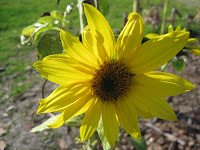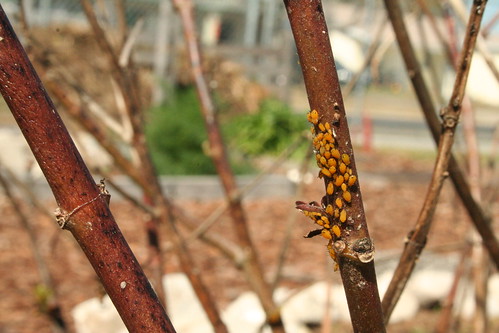
It was a warm sunny day in the garden. The hot rays from the sun gave the kids lots of energy, and we had a lot of fun being out in the garden. First, McDevitt’s kindergartners visited the garden. We continued to discuss how to make observations of nature using all of the senses: taste, touch, sight, hearing, and smell. Last week, they smelled the different herbs in our garden and tasted the different types of plants that are being grown in our garden. This week, the kids focused on using their sense of hearing and were asked to make a sound map of the garden. Everyone sat and listened to what was going on around them and then drew the sounds they heard, with each individual sound represented by a dynamic line or picture. We then explored our sense of touch by rolling down the hill next to the garden. After reaching the bottom, the kids were asked to describe the different textures they felt while rolling. Was the ground hard or soft? cold or warm? soft or rough?
 Next, Mobley’s second grade class joined us in the garden. They were asked to hunt for bugs in the garden. When a bug was found we had them write down what type of bug, a brief description of it, were it was located, and if it is helpful or detrimental to the life of the garden. After finding a number of different species of bugs, they chose one of them to explore more in depth. The kids drew a picture of the bug of their choice after closely observing it and then listed at least three adaptations the species for living in the garden. For example, an adaptation in lady bugs would be their wings which allow them to fly from plant to plant in order to find food.
Next, Mobley’s second grade class joined us in the garden. They were asked to hunt for bugs in the garden. When a bug was found we had them write down what type of bug, a brief description of it, were it was located, and if it is helpful or detrimental to the life of the garden. After finding a number of different species of bugs, they chose one of them to explore more in depth. The kids drew a picture of the bug of their choice after closely observing it and then listed at least three adaptations the species for living in the garden. For example, an adaptation in lady bugs would be their wings which allow them to fly from plant to plant in order to find food.
The last class of the day was Smith’s first grader class. The kids were asked to help up water all the plant in the garden so that they would be able to grow big and strong. The kids really enjoyed watering the plants. Overall, it was a beautiful, successful and fun day in the garden on this Friday before spring break.









































 The morning shift investigated a strange phenomena occurring in the aloe bed…not sure if the soil is too wet or if something is eating it. Some of the points are shriveled and browned and some plants are just falling apart. Check out the picture, if you can.... What do you think?
The morning shift investigated a strange phenomena occurring in the aloe bed…not sure if the soil is too wet or if something is eating it. Some of the points are shriveled and browned and some plants are just falling apart. Check out the picture, if you can.... What do you think?





